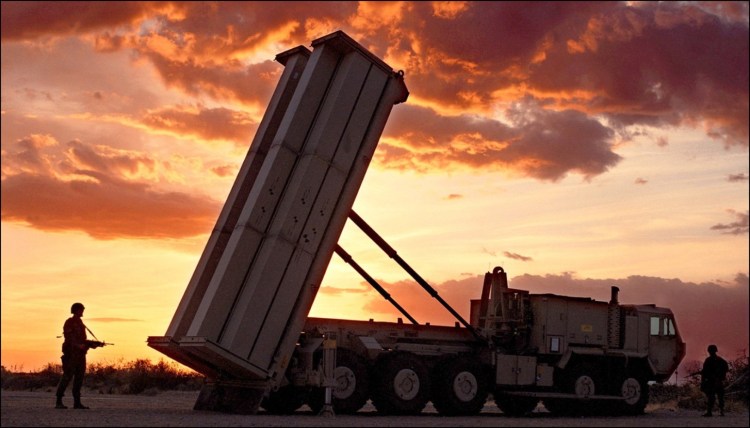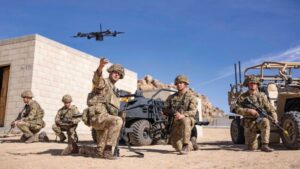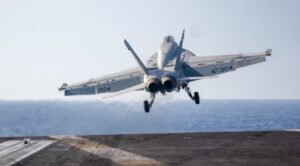THAAD – Terminal High Altitude Area Defense
THAAD is one of America’s three premiere air defense missile systems. The other two are the Patriot PAC-3 and the Aegis Standard 3 (SM-3). These systems all share a type of warhead referred to as a kinetic kill vehicle (KKV). This is a non-explosive warhead that destroys an incoming ballistic missile by means of a high-speed collision. This is a method that demands the utmost precision. It has been described as “hitting a bullet with a bullet.”
Israel’s Arrow 3 is a development of the KKV technology that uses thrust vectoring to achieve the same results. We will not discuss the Arrow 3 further here, except to say it exhibits the same strengths and weaknesses as the American systems.
The KKV technology is required because an explosive warhead might only damage the incoming missile, causing the incoming warhead to break off and continue on its trajectory toward its target. It might fall short or long, but for a nuke, this could be disastrous. It’s missing Manhattan and nuking Brooklyn.
Following Iran’s missile strike on Israel on October 1, the United States is deploying a THAAD battery to Israel. This is to bolster Israel’s air defense in anticipation of an Israeli attack on Iran that will undoubtedly spur retaliation.
A great deal has been made of this deployment, along with 100 US troops to operate the battery. To the best of this writer’s knowledge, this is not the first time a THAAD battery has been deployed to Israel. Indeed, it is likely there was already a THAAD battery deployed to Nevatim Airbase on October 1. If that is true, this will be the second of two THAAD batteries in theatre.
The US Army’s THAAD and the Navy’s Standard 3 are the more sophisticated of the ABM systems. The Patriot PAC-3 is somewhat older, an upgrade from the PAC-2, which has an explosive warhead.
THAAD – Terminal High Altitude Area Defense
THAAD is one of America’s three premiere air defense missile systems. The other two are the Patriot PAC-3 and the Aegis Standard 3 (SM-3). These systems all share a type of warhead referred to as a kinetic kill vehicle (KKV). This is a non-explosive warhead that destroys an incoming ballistic missile by means of a high-speed collision. This is a method that demands the utmost precision. It has been described as “hitting a bullet with a bullet.”
Israel’s Arrow 3 is a development of the KKV technology that uses thrust vectoring to achieve the same results. We will not discuss the Arrow 3 further here, except to say it exhibits the same strengths and weaknesses as the American systems.
The KKV technology is required because an explosive warhead might only damage the incoming missile, causing the incoming warhead to break off and continue on its trajectory toward its target. It might fall short or long, but for a nuke, this could be disastrous. It’s missing Manhattan and nuking Brooklyn.
Following Iran’s missile strike on Israel on October 1, the United States is deploying a THAAD battery to Israel. This is to bolster Israel’s air defense in anticipation of an Israeli attack on Iran that will undoubtedly spur retaliation.
A great deal has been made of this deployment, along with 100 US troops to operate the battery. To the best of this writer’s knowledge, this is not the first time a THAAD battery has been deployed to Israel. Indeed, it is likely there was already a THAAD battery deployed to Nevatim Airbase on October 1. If that is true, this will be the second of two THAAD batteries in theatre.
The US Army’s THAAD and the Navy’s Standard 3 are the more sophisticated of the ABM systems. The Patriot PAC-3 is somewhat older, an upgrade from the PAC-2, which has an explosive warhead.
Why now?
In a sense, more is being made of this deployment than it deserves. Particularly since it is not the first time THAAD has been deployed to Israel. One theory is that the US is providing THAAD as a quid pro quo for Israel not striking Iran’s nuclear or oil facilities. For more on that story, see the SOFREP article, Compensation for Israeli Restraint.
A more credible theory is presented by the Financial Times (a reliable mouthpiece of US-UK policy) in today’s article First FT: Israel Grapples with Shortage of Air Defense Missiles. In this article, The article states:
“The US is racing to help close gaps in Israel’s protective shield. On Sunday the Biden administration announced the deployment of a Terminal High Altitude Area Defense (THAAD) anti-missile battery, ahead of an expected retaliatory strike from Israel on Iran that risks further regional escalation.
“‘Israel’s munitions issue is serious,’ said Dana Stroul, a former senior US defense official with responsibility for the Middle East. ‘If Iran responds to an Israel attack [with a massive air strike campaign], and Hezbollah joins in too, Israel air defenses will be stretched.’ US stockpiles are not limitless, she added.”
That’s bad news for Ukraine, which must be anxiously watching developments in the Middle East. The article claims that Israel has shot down “the vast majority” of incoming threats, a statement with which this writer disagrees. That case was made in Iran Missile Attack Overwhelms Israeli Air Defenses. In any event, the point is that Iran is pursuing a swarm strategy that is overwhelming Israeli and coalition air defenses with sheer weight of numbers. Two swarm attacks – one on April 13 and another on October 1 – severely depleted Israel’s and the coalitions inventories. It makes complete sense for the US to reinforce the defenses with another THAAD battery.
How THAAD Works
THAAD consists of two elements – a powerful X-band radar and an interceptor missile. The radar is outstanding. When THAAD was deployed to South Korea, the Chinese went berserk. Not because they were worried about THAAD missiles intercepting North Korean BMs, but because the THAAD radar could reach deep into China. THAAD radar could provide early warning and tracking of Chinese ballistic missiles for Aegis ABMs deployed on Arleigh Burke class destroyers in the Pacific.
Anecdotally, THAAD radar has been deployed to Israel for quite some time. Its presence and characteristics would have been detected and catalogued during the first Iranian attack on April 13. This was the attack used by Iran and Russia to map the Israeli and coalition air defense network (Electronic Warfare 101). This was followed by deployment of the first THAAD battery to protect air bases, and the current deployment of a second battery.
All three of these missile systems are in short supply. Vast numbers of Patriot missiles and launchers have been destroyed in Ukraine. Germany had 20 batteries at the beginning of the Ukraine war and now has five. There are only about 400 Standard 3 missiles in inventory, and 12 are manufactured each year. On October 1, two US destroyers fired 12 Standard 3s against 300 incoming Iranian missiles – an entire year’s production. THAAD is in even shorter supply. One battery is supplied with 6 launchers and 48 THAAD missiles (8 missiles per launcher). That won’t win many small wars.
Figure 1. Operation of THAAD battery.
An introduction to THAAD can be found here: A Brief Introduction to THAAD.
Theoretical hit probability is at best 0.8 and at least two interceptor missiles have to be fired for every incoming threat. Realized hit probability may be considerably less than 0.8.
Figure 1 is a schematic that shows THAAD’s operation. The THAAD radar detects the incoming threat. Tracking data is transmitted to the launcher, which fires at least one, possibly two or even three missiles for each threat.
The THAAD interceptor and Kinetic energy Kill Vehicle is shown in Figure 2. It is a telescope with a sensitive IR-imaging camera. Radar guidance directs the KKV to the vicinity of the target. The THAAD KKV is hypersonic, traveling at about 1.6 miles per second (Mach 8). But then, so is its target. Imagine – the combined closure rate of interceptor and target is over 3 miles per second. At 5 miles per second, Standard 3 is even faster.
Figure 2. THAAD Interceptor and Kinetic Kill Vehicle
About two seconds from impact, the KKV’s eyes open and the telescope registers the incoming warhead. The KKV’s directional thrusters then kick in, making fine adjustments to the KKV’s course in the final moments before impact.
Defeating THAAD
As previously mentioned, all three missile systems (Patriot PAC-3, THAAD, Standard 3) use the same KKV technology. So does Israel’s Arrow 3. Technology to defeat this ABM paradigm has been around since the early 2010s and was successfully tested by North Korea. It is not difficult to employ and has almost certainly been implemented by Iran as well. It was probably employed during the attack of October 1, but that information is certainly classified.
To defeat THAAD (and Patriot PAC-3, Standard 3, and Arrow 3), the adversary uses decoys.
In the first instance, the adversary would simply detach the warhead of the incoming missile from the booster stage. He would then cut the booster stage into several pieces of any desired size. The technology used to slice up the booster is no different from that used to separate earlier stages. It’s trivial. The booster pieces will then fly along with the warhead at the same speed and on the same trajectory.
When the THAAD KKV’s eyes open, two seconds from impact, its telescope will see several pinpoints of light instead of just one (see Figure 3).
Figure 3. Target Cluster – Warhead and Decoys, 2 seconds to Impact
Remember that the KKV and warhead are approaching each other at a hypersonic closure velocity of over three miles per second (Mach 16). THAAD has less than two seconds to decide which of the four points to lock and kill.
Any AI system requires a database and human-derived rules upon which to operate. In this case, a human being has to tell the program what to do. If we think the warhead will be smaller than the pieces of the booster that were sliced up, we tell the KKV to lock on the smallest piece. If we think the warhead is least reflective, we tell the KKV to kill the least bright piece.
But even that AI can be defeated if the aggressor deploys other decoys or balloons. Decoys specifically configured to be the same size and reflectivity as the warhead can be stacked like ice cream cones behind the warhead. They can be deployed during separation and will look exactly like the warhead to the KKV’s eyes.
Another method that can be used separately or in conjunction is the deployment of balloons. Like decoys, they can be inflated and deployed upon separation. In space, where there is no atmosphere, balloons will travel at the same velocity and on the same trajectory as the warhead. The balloons can be painted so as to appear the same size or reflectivity as the warhead. Alternatively, the balloons and decoys can be made to randomly appear larger or smaller, brighter or darker than the warhead. In any case, the THAAD’s AI will be completely confused.
It is well worth emphasizing that, during the attacks of April 13 and October 1, Iran and Hezbollah fired so many ballistic missiles and artillery rockets that the sky was literally filled with threats. One only needs to watch the videos taken that night. Threats outnumbered interceptors by such a wide margin that the use of decoys was superfluous.
These issues are discussed in detail in Lewis & Postol: Technical Analysis of Flaws in Standard 3. Keep in mind that in principle the Standard 3 KKV technology is the same as THAAD KKV technology.
Conclusions
It has long been postulated that adversaries would develop countermeasures that would render ABM systems obsolete by the time they were deployed. We know that North Korea successfully tested the booster-cutting and decoy deployment techniques as far back as 15 years ago. Russian ICBMs are all configured to deploy decoys. It is certain that Iranian and Chinese missiles are similarly equipped.
Throughout the noughties and 2010s, a fierce debate raged about the effectiveness of ABM defense and the use of decoys. There were contracts with a great deal of money and political capital at stake. All three ABM systems have since been procured and deployed. Now, for the first time, we are able to test their effectiveness in live combat conditions.
The jury is still out; the proof will be in the bomb damage assessment.
About the Author:
Cameron Curtis
Cameron Curtis may be reached at: [email protected]
He is the author of the Breed action thriller series, which is available on Amazon. The stories are adrenaline-fuelled and emotionally engaging. The novels combine credible premises based on current events, technical detail, and propulsive plotting.
Check out his new Breed thriller, BLOWBACK, here: BLOWBACK by Cameron Curtis available for download now. The story involves the theft of a thermonuclear bomb (H-Bomb) that includes a fission device like the ones described in this article.



